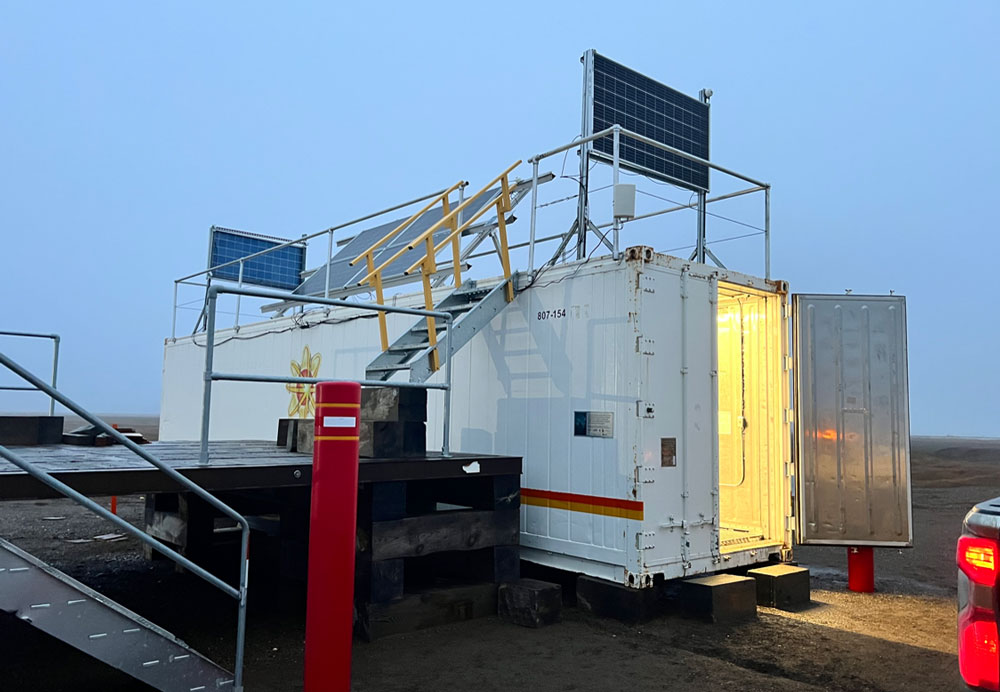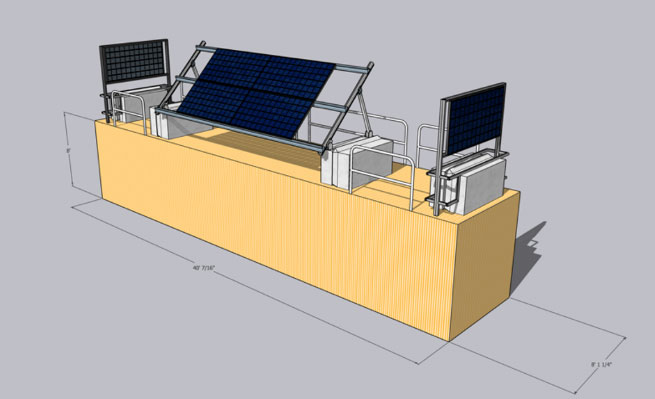Sandia researchers team up to launch renewable energy research above the Arctic Circle

Oliktok Point, Alaska, is one of few accessible locations within the United States above the Arctic Circle. The wind chill can plummet to minus 70 degrees Fahrenheit and structures are covered with ice most of the year. These extreme weather conditions make Oliktok Point an ideal location for Sandia researchers to install photovoltaic panels to better understand solar generation in extreme and remote environments, including north of the Arctic Circle.
“Establishing that solar can generate energy for most of the year, and determining which system designs produce the most power, matched to time-of-day, should help accelerate the growth of solar in Alaska, reducing the need for costly and carbon-emitting diesel fuel and increasing the energy security of remote communities,” explains Laurie Burnham, Sandia’s photovoltaics and materials technology project lead.
The Arctic region has limited measurement stations for conducting research; therefore, selecting a testing location that experiences brutal arctic weather and harsh shoreline conditions is vital to understand the wide array of environmental factors the photovoltaic panels will endure.
“[Oliktok Point is] a very environmentally relevant field site — it checks all the boxes. We go from permanent ice through the winter, with permafrost, to the sea ice breaking up, to open water and a melt season where the ground softens and turns to mud,” said Andrew Glen, manager of Sandia’s atmospheric sciences.
Solar in the Arctic
In September, Sandia installed a small, 4.3-kilowatt photovoltaic system atop a shipping container at Oliktok Point. The new photovoltaic modules are bifacial, or photoactive on both sides. This design allows solar radiation to reach the photovoltaic cells on one side and reflected light to also reach the opposite side of the same cells. As a result of receiving light on both sides, bifacial modules can produce 15% to 50% more power, depending on the amount of reflectivity and the type of solar cell.
Bifacial modules produce the highest energy gains when the surrounding reflection of solar radiation is high, as is typical of a sunny day in snowy environments. Data collected at Oliktok Point will track those daily energy gains and help develop predictive models of energy performance based on the tilt angle and orientation of the solar modules.

“Alaska, and Oliktok in particular, represents an edge case for PV deployment,” said Bruce King, director of Sandia’s Photovoltaic Systems Evaluation Lab. “Learning about edge cases helps inform conventional system design and may identify opportunities to increase energy harvest that might not otherwise be considered. This can be particularly important for PV deployments in other geographic areas that are also not optimal.”
Mark Ivey, senior engineer in the Geoscience Research and Applications Center at Sandia, is excited to partner with Sandia’s photovoltaic researchers in the Arctic.
“Not only are you seeing unique science — like the clouds do really different things up there — but also, it’s a very tough environment. It’s a marine environment. You’re going to have salty conditions and corrosion conditions. It’s Arctic, of course, so in that regard, it may be a little tougher. This past winter we had high winds with very low temperatures at minus 45 Fahrenheit or so ambient, so the wind chill was minus 70 at times. That’s tough on equipment; it’s tough on people,” Mark said.
Sandia’s solar and arctic expertise in situ
Sandia has more than 50 years of photovoltaic research expertise with work that includes decades of outdoor reliability assessments, performance modeling and developing characterization and validation methodologies for fielded systems and components. Nonetheless, additional research is needed to understand the climatic stresses that impact photovoltaic performance and reliability at high latitudes with extreme weather, where field studies are lacking.
“At Sandia, we have a breadth of knowledge that crosses multiple disciplines. So, we can take the folks who are really experienced with PV, and we can bring our decades of Arctic experience and location to that and try merging this together. Not many institutions can do that,” Andrew said. “It allows the PV engineers to test out systems like solar power in Arctic environments, which behave very differently than those deployed in midlatitudes or closer to the equator. We get to test our reliability of instruments in terms of the cold weather exposure; things tend to break a lot more easily when you’re next to the coast and you’re in minus 70 degrees.”
The team hopes that their research will support the growth of solar in Alaska and other northern climates by demonstrating that solar is a viable energy source, even in extreme cold climates with limited or no sun in winter. Equally important, the data from Oliktok Point will quantify which system designs and technologies are most efficient in northern environments, enabling the roll out of climate-optimized photovoltaic systems. These findings will be highly beneficial to remote communities that are now heavily reliant on carbon- and particulate-emitting diesel generators and to U.S. military outposts, for whom energy surety is critical.
Sandia’s Arctic team also conducts research on coastal erosion, atmospheric measurements and corrosion conditions. Eroding shorelines and changes in permafrost are just two examples of factors researchers must consider when deploying test equipment above the Arctic Circle.
Immediate and long-term impacts
As the effects of climate change continue to impact the world, the Arctic is quickly becoming more strategically important as melting ice opens shipping lanes and increases access to resources.
“This research will accelerate the adaptation of renewable energy technologies for use in high-latitude environments. As early adopters, communities in Alaska are accelerating this technology adaptation. Climate change is rapidly transforming the Arctic, and we need renewable energy technology options to meet energy needs for a growing range of research, commercial and security activities in the region,” said Abraham Ellis, senior manager of Sandia’s Renewable Energy Technologies group.
Understanding and predicting the reliability of alternative power sources in the Arctic could become vital for national security, ongoing arctic research and as a key resource for energy equity in remote locations.
“The last I checked, we were paying something like $9 a gallon for fuel on the North Slope for diesel. You know the native communities have to pay that too. They depend on all-terrain vehicles and snow machines for their subsistence hunting. So, it’s a big deal,” Mark said.
“Beyond combating climate change directly, PV can help mitigate the effects of climate change,” Bruce said. “Local and community generation can provide power during times of grid disruption due to climate-driven weather events and reduce demand during peak hours that could otherwise lead to brownouts. As this system is also 100% off-grid, it may also help inform community solar, disaster relief and other dispersed power applications.”
The new photovoltaic array at Oliktok Point has the potential to inform future photovoltaic deployments in extreme conditions, helping accelerate the deployment of non-carbon emitting energy sources across northern regions of the U.S. It’s work that capitalizes on Sandia’s diverse and long-standing expertise in renewable energy, climate change research and the commitment to energy equity and development of new tools that could impact communities across the world.
“This research can really make a difference by deploying PV in different environments. The variation is critical,” Andrew said. “Local villages in Alaska don’t always have reliable power, so bringing PV to test and hopefully deploy in the future could have a huge impact on energy access and energy equity in the Arctic. It’s really about improving reliable access to energy in a responsible way, but it doesn’t happen overnight.”